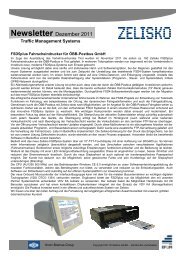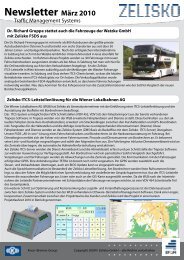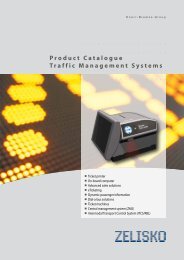Annual Report 2012 - Knorr-Bremse AG.
Annual Report 2012 - Knorr-Bremse AG.
Annual Report 2012 - Knorr-Bremse AG.
Create successful ePaper yourself
Turn your PDF publications into a flip-book with our unique Google optimized e-Paper software.
<strong>Report</strong><br />
63<br />
The sound capsule encasing the compressor also has to withstand a range of external influences. In<br />
the Russian market, for instance, the air supply unit has to cope with extremely low temperatures<br />
down to minus 50 degrees Celsius.<br />
To prevent overheating of the capsule, <strong>Knorr</strong>-<strong>Bremse</strong> has also developed a mechanically operated<br />
radial fan linked to the compressor, which automatically switches on to extract hot air when the compressor<br />
is running.<br />
New hydraulic brake caliper installed in monorail system<br />
Canadian manufacturer Bombardier is to deliver 54 vehicles for the new “Expresso Tiradentes” monorail<br />
line in São Paulo, and <strong>Knorr</strong>-<strong>Bremse</strong> will be supplying brake discs, brake calipers, supply units and brake<br />
control units for the hydraulic braking system, which is designed for speeds up to 80 km/h. Developing<br />
the brake caliper was a particular challenge, as the brake discs can reach temperatures of over 500<br />
degrees Celsius. For the new caliper <strong>Knorr</strong>-<strong>Bremse</strong> developed a lightweight brake frame and carrier<br />
and a special ribbed pressure plate with the option of an additional heat-insulating disc. The system<br />
also uses special heat-resistant brake pads.<br />
The new brake caliper is also highly modular in design – the only difference between applications for<br />
braking forces of 8 kN and 10 kN is a thicker spacer washer.<br />
IFE develops new access system<br />
The new E3 access system developed by <strong>Knorr</strong>-<strong>Bremse</strong> subsidiary IFE has been specially designed to<br />
meet the highest standards of thermal and sound insulation and ensure operability under harsh winter<br />
conditions. Active locking mechanisms in the lower part of the door mean the module can cope with<br />
speeds of up to 200 km/h, including trains passing in the opposite direction, and withstand dynamic<br />
load peaks of up to 3,000 Pa, with static loads of up to 4,000 Pa. The specially developed door leaf has<br />
an additional insulation layer for maximum sound and heat insulation.<br />
The new E3 access<br />
system comes with<br />
particularly high<br />
levels of thermal and<br />
sound insulation.<br />
As in the past, each door is equipped with at least two steps. The so-called Track Access Device (TAD)<br />
consists of separately powered sliding steps, with the upper one designed for passengers and the<br />
lower one, controlled by a key switch on the outside of the car, ensuring safe entry and exit for the<br />
driver. The majority of parts requiring maintenance are identical on both steps – which reduces spares<br />
inventory and maintenance costs.<br />
During the year under review the new access systems were installed for the first time in the latest version<br />
of the FLIRT family of cars built by Stadler for Norwegian Railways.<br />
New HVAC unit for metro applications<br />
Rail vehicle air conditioning systems must turn in top performance reliably for hours on end, ideally make no<br />
noise at all and, in metro cars in particular, must be as compact as possible. For precisely these applications,<br />
in the year under review <strong>Knorr</strong>-<strong>Bremse</strong> subsidiary Merak presented a new and extremely flat HVAC unit.<br />
Taking account of the very restricted installation envelope in metro cars, the unit, which is built into the<br />
car roof, measures just 290 mm at its highest point. Its integrated air intake means there is no need for<br />
an additional vehicle-side air supply to the system.<br />
The new, extremely<br />
flat HVAC system from<br />
Merak has been<br />
specially designed for<br />
metro applications.<br />
Thanks to its flexible design, the newly developed HVAC unit can be adapted to meet a wide variety of<br />
customer requirements and climate conditions with relative ease. Despite its robust stainless steel<br />
frame and copper coils, the unit is far lighter than comparable systems and easy to maintain.



![1 Newsletter 2013 Version 0 92 [Kompatibilitätsmodus] - Zelisko](https://img.yumpu.com/50939577/1/184x260/1-newsletter-2013-version-0-92-kompatibilitaatsmodus-zelisko.jpg?quality=85)




![Backofficelösung ZMS [PDF, 740 kB] - Zelisko](https://img.yumpu.com/33964695/1/184x260/backofficelaasung-zms-pdf-740-kb-zelisko.jpg?quality=85)

![Geschäftsbericht 2012 [PDF, 13 MB] - Zelisko](https://img.yumpu.com/31517535/1/184x260/geschaaftsbericht-2012-pdf-13-mb-zelisko.jpg?quality=85)


![Produktkatalog Gesamtlösungen [PDF, 4 MB] - Zelisko](https://img.yumpu.com/22973479/1/182x260/produktkatalog-gesamtlaasungen-pdf-4-mb-zelisko.jpg?quality=85)
![ITCS Datenblatt [PDF, 804 kB] - Zelisko](https://img.yumpu.com/22855155/1/184x260/itcs-datenblatt-pdf-804-kb-zelisko.jpg?quality=85)
![Fahrscheindrucker FSD5plus [PDF, 934 kB] - Zelisko](https://img.yumpu.com/22822643/1/184x260/fahrscheindrucker-fsd5plus-pdf-934-kb-zelisko.jpg?quality=85)
